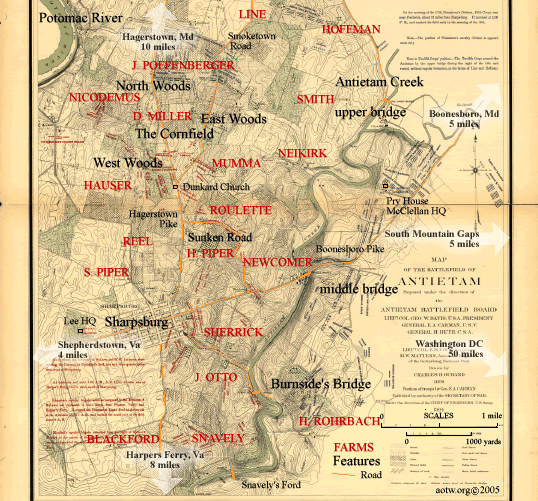 Open main menu
Open main menu
 Open main menu
Open main menu
Wednesday, September 17, 1862 ... the single bloodiest day in American history.
This page will give you an overview of that terrible fight near the small town of Sharpsburg, Maryland. For background information about events leading to this titanic clash ...
This map shows the major landmarks on and around the battlefield of Wednesday, September 17, 1862. These are the places most often mentioned in reports and descriptions of the battle.

Morning -- 6AM to 9AM: Union assaults and Confederate counters in the northern part of the field including combat in the Cornfield, East and West Woods, and around the Dunker Church.
The battle opened at dawn on the 17th when Union General Joseph Hooker's artillery began a murderous fire on Jackson's men in the Miller cornfield north of town. "In the time I am writing," Hooker reported, "every stalk of corn in the northern and greater part of the field was cut as closely as could have been done with a knife, and the [Confed.] slain lay in rows precicely as they had stood in their ranks a few moments before." Hooker's troops advanced, driving the Confederates before them, and Jackson reported that his men were "exposed for near an hour to a terrific storm of shell, canister, and musketry."
About 7 am Jackson was reinforced and succeeded in driving the Federals back. An hour later Union troops under General Joseph Mansfield counterattacked and by 9 o'clock had regained some of the lost ground. Then, in an effort to extricate some of Mansfield's men from their isolated position near the Dunker Church, General John Sedgwick's division of Edwin V. Sumner's corps advanced into the West Woods. There Confederate troops struck Sedgwick's men on both flanks inflicting appaling casualties.
Mid-day -- 9AM to 1PM: The attack on the Confederate Center, mostly concentrated in and around the Sunken Road (or Bloody Lane).
Meanwhile, General William H. French's division of Sumner's corps moved up to support Sedgwick but veered south into Confederates under General D. H. Hill [later reinforced by Anderson's division] posted along an old sunken road separating the Roulette and Piper farms. For nearly four hours, from 9:30 am to 1 pm, bitter fighting raged along this road (afterwards known as Bloody Lane) as French, supported by General Israel B. Richardson's division, also of Sumner's corps, sought to drive the southerners back. [Although the rebel line was at last broken by enfilading fire from regiments of Richardson's division, no further Union troops were sent into the gap.] Confusion and sheer exhaustion finally ended the battle here and in the northern part of the field generally.
Afternoon -- 1PM to 5PM: The Federal assault across the Lower Antietam bridge at the southern end of the battlefield, their drive on Sharpsburg and the Confederate rear, and General A.P. Hill's timely return from Harpers Ferry to throw them back.
Southeast of town, Union General Ambrose E. Burnside's troops had been trying to cross a bridge over Antietam Creek since 9:30 am. Some 400 Georgians [General Toombs' brigade] had driven them back each time. At 1 pm the Federals finally crossed the bridge (now known as Burnside Bridge) and, after a 2-hour delay to reform their lines, advanced up the slope beyond. By late afternoon they had driven the Georgians back almost to Sharpsburg, threatening to cut off the line of retreat for Lee's decimated Confederates. Then about 4 pm General A. P. Hill's division, left behind by Jackson at Harper's Ferry to salvage the captured Federal property, arrived on the field and immediately entered the fight. Burnside's troops were driven back to the heights near the bridge they had earlier taken. The battle of Antietam was over.
[Both armies held their positions all through the 18th, and] the next day, Lee began withdrawing his army across the Potomac River.
-- text courtesy of the US National Park Service (1998); my notes in brackets